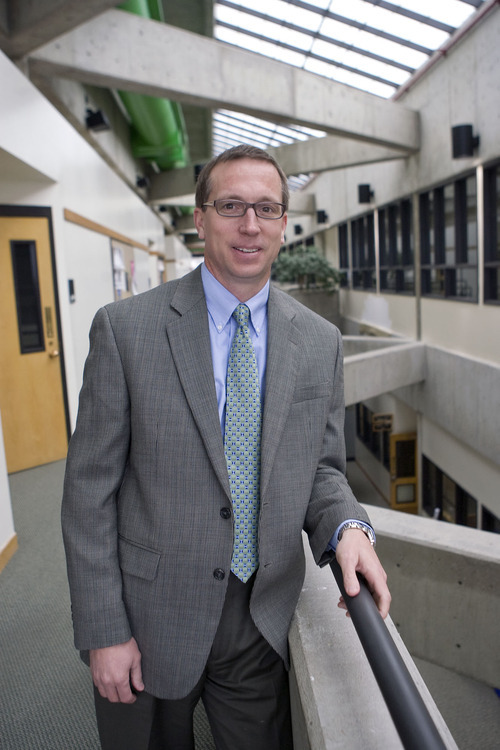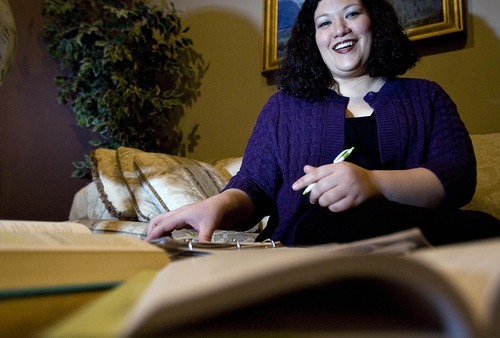This is an archived article that was published on sltrib.com in 2010, and information in the article may be outdated. It is provided only for personal research purposes and may not be reprinted.
Orem • Nicolle Johnson would have been happy to leave Utah Valley University with an associate degree in 2008, a decade into her college career. But that was before she was invited to participate in faculty research under an initiative UVU launched to keep students more tethered to its commuter campus.
Her job — studying the reasons Utah women don't attend college — motivated her to stay in school in quest of twin degrees in communications and business, says the 33-year-old Virginia transplant.
Now, UVU officials hope more students will get a taste of "engaged learning" as the school explores ways to improve its dismal completion rates. As UVU piled on four-year degree programs leading to its 2008 transition to a regional university, its graduation rate wallowed in the basement of higher education. This standard measure of student success calculates schools' share of first-time, full-time students who graduate within six years.
UVU's rate is 18 percent for such students who entered in 2003, according to Department of Education data. For student-athletes in that group, UVU is dead last among NCAA's 335 Division 1 schools. Just 31 percent graduated, far below the national average of 79 percent, according to the athletics association.
The previous year's overall rate, 15 percent, earned UVU a spot on Washington Monthly's list of "dropout factories" last summer, causing much heartburn for Linda Makin, the school's planning and budget director.
Makin and other UVU officials see the designation as grossly inaccurate because it is based on data geared toward traditional, selective schools where high-achievers enroll right out of high school. UVU is the new norm in higher education, an open-admission school that takes anyone with a high school diploma, including many who are poorly prepared, transfers, working adults or parents.
"We're serving nontraditional students in nontraditional programs," Makin says.
The federal data do not capture the majority of UVU students, but that doesn't mean there isn't room for improvement.
—
Stopping a 'revolving door' • Reversing declines in college completion rates is a national priority, but in Utah it's especially important. According to the College Board, only 49 percent of Utah baccalaureate students graduate in six years and 40 percent of associate's degree-seeking students graduate in three years.
Plugging the leaks in the degree pipeline is one of three "strategic" prongs outlined in the state's new higher education master plan, crafted to boost the portion of adults holding college degrees to at least 55 percent.
To reach this goal, UVU will be doing the heavy lifting, along with Utah's other big open-admissions schools — Salt Lake Community College, Dixie State College and Weber State University — as opposed to the research institutions.
According to the Higher Ed Utah 2020 plan, which Utah Regents approved this month, 370,000 Utahns, or 28 percent of the adult population, have attended college without completing a degree. Every year, thousands more drop out or stumble along without making much progress toward graduating.
"We have to stop the revolving door," Makin says.
The key at UVU is getting students more involved in campus life and more engaged with their studies by getting faculty to act as mentors, said philosophy professor Brian Birch.
"We're making the student experience more meaningful. We want students staying on campus involved with research, internships. There are a variety of projects," said Birch, who was recently promoted to UVU's associate vice president of academics affairs, who oversees engaged learning. "The challenge is we have a high teaching load. It doesn't give faculty the time to devote enough time to students [outside class]."
Nicolle Johnson's story shows how faculty mentors can make a difference. She started at Mary Baldwin College right out of high school and later transferred to Southern Virginia University, both tiny private schools.
"I was on the fast track. I started at a really good school and went for a year and I ran out of funding," she says. Johnson later moved to Utah and enrolled at UVU in 2007. Her associate's degree would have been the end of the line, but management professor Susan Madsen asked her to join the Utah Women and Education Project — UVU-supported research based on in-depth interviews with a few hundred young Utah women.
"It changed my life," Johnson says. "The biggest change was that Susan cared about me individually. It didn't seem like just a job; she looked for opportunities for me to improve, to do things on campus that would stretch me."
She plans to graduate in spring 2012 and will serve an unpaid internship this summer with the Worldwide Organization for Women at the United Nations' Geneva office — if funding comes through.
—
Connecting students • UVU secured federal seed money in 2005 to change the university's culture and promote student success. Programs like the Three-Week Project and Early Alert prepare first-year students to navigate college life and trigger intervention when they fall overboard, according to Michelle Taylor, UVU's director of enrollment management.
Several studies show student success correlates well with involvement in campus life, but UVU has few facilities for nonacademic activities and no residence halls. So officials have partnered with off-campus apartment complexes to imbed resident advisers in these buildings. The school also hopes to build an intramural complex on 100 acres at the former Geneva Steel site and to use student fees to build and operate the proposed $42 million Student Life and Wellness building.
UVU's retention rate has responded, jumping from 44 to 60 percent, which is behind the school's recent enrollment spikes, Taylor says. New freshman are not driving enrollment, but rather returning students like Johnson, who stick around to pursue bachelor's degrees.
Meanwhile, the enrollment boom has created new problems that could be holding down completion rates. Key classes are full. UVU student leaders last winter warned lawmakers that required courses are not reliably available, thwarting many students' progress toward graduation.
Officials have expanded online offerings and opened new sections on Friday nights and Saturdays. These fill up while weekday afternoon slots remain open because so many students have work obligations then. Officials perennially plead with the Legislature for the funds to build more space. A massive addition to the science building is under way, and the UVU master plan calls for new fine arts and general classroom buildings and business building expansion. But these projects will do little more than keep pace with projected enrollment gains.
Looking back • Utah Valley University
R The Orem school has piled on four-year degree programs in recent years — now numbering 61 — as it prepared for its 2008 transition to university status. But only a small portion of students are earning bachelor's degrees, according to data gathered by the U.S. Department of Education. The 33,000-student UVU has launched a number of initiatives to keep students on track to graduate.
Those initiatives have led to a big uptick in enrollment and retention rates (the portion of freshman who return to school the next year), officials say, but it will be a while before that is apparent in graduation data. On a per-student basis, UVU has the least amount of space and smallest state appropriation of any Utah college.









